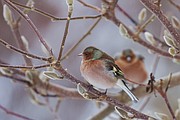Landscaping options help lure, protect birds
The Grow Native movement is becoming more and more accepted by home/land owners who appreciate the gifts of birds and wildlife that come with natural planting.
With winter’s birds flocking to our bird feeders and taking shelter in wooded surroundings, why not take the time now to consider the birds in your spring landscaping plans?
A few small conifers and/or cone/seed-bearers, such as Juniper, Mountain ash, Serviceberry, Hawthorn, Elderberry, Rocky Mountain maple, Alder, Sumac — and willows and shrubs, which include Snowberry, raspberry, currant, honeysuckle, Oregon grape, thimbleberry, dewberry and kinnikinnick — are just the beginning of a lengthy list of wild possibilities that not only enhance your property but provide for the birds as well.
Too, a variety of seed-bearing flowers and grasses, including the four native species of roses, not only regale the surroundings with fragrance, but provide low-growing cover for ground-feeders and in the case of the roses, leafy, thorny shelter followed by nutritious rosehips for winter food. The following are a few ideas for consideration.
Serviceberry (Amelianchier ulnifolia), technically a shrub, can literally turn into a great tree-like focal-point, so give it plenty of room. It can add beauty and drama when planted as a focal point or in front of evergreens, which provide a dark green counterpoint to Serviceberry’s green leaves and lovely, white-petaled flowers in Spring, turning to red and gold foliage and blue (seedy) berries , in the fall. The dried berries remain on the branches all winter, providing a welcome food source for birds. Elderberry (Sambucus cerulea) is another possibility. Its dark green pinnate leaves and white flower umbrellas turn to a gorgeous flaming display with dusty/dark blue berry clusters. Like Serviceberry, it is a hardy native and can get very large, so let it stand on its own or fronting big trees.
For beauty and density on a smaller scale, consider any of the currants (Ribes): Red-flowering, blood currant, etc. All currants have the beautiful drooping flower clusters in shades of red or pink, sometimes white — looking like mini-fuchsias , later joined by the foliage, and then setting into the fruit which can be red or black. Great for jelly.
Another consideration is Snowberry (Symphoricarpos albus) which has pretty rounded lighter green leaves and tiny pink bell-flowers during summer, turning slowly to a fall-yellow shrub loaded with white, waxy berries beloved by grouse.
The wild Rubus family, raspberry and blackberry, are always welcome. The red raspberry and blackcaps are smaller but just as sweet versions of the domesticated varieties, and the great arching branches of the large wild blackberry provide dramatic elegance, delectable fruit and priceless bird shelter. The ground-dwelling Dewberry (trailing blackberry – Rubus), while sporting nasty, foot-tangling, needled vines, is ideal for slopes or open areas where you don’t want anyone intruding, offering small but delectable black berries in the early autumn, however.
Other groundcover berries include Kinnikinnick, preferring dry, sunny sites and the elegant, delectable Alpine strawberry (fragaria) which prefers a bit more moisture but as all natives, loves our naturally acidic soil.
For berry trees, you can’t beat Mountain ash. Sitka Mountain Ash (Sorbus sitchensis) is our native, shrubbier, variety, with large, orange-red berries. It transplants well and is available at some of our area nurseries. It offers lovely green-to-yellow-to-red pinnate leaf fronds and is an asset to any landscape.
The native Hawthorn (Crategus) — often referred to as “Thornapple” — is attractive in its own way, sometimes growing in a gnarly, almost Oriental, manner. Its vicious thorns somewhat negate its popularity, but provide wonderful protection for songbirds, who also appreciate the “haws” or fruits.
Other, (shorter) possibilities include Chokecherry (Aronia), which grows as a small tree or shrubby bush depending on site placement. The leaves turn a glorious red and the glossy red or black berries make a good jelly. The shrubs present a showy display of delicate white flowers in May. Sumac, too, is an attractive choice. Staghorn sumac, with its “furry” stems and amazing red flower-seed clusters, is a showstopper, and while it’s slow to get started, will become a big, beautiful specimen with winter-red leaves to enhance the bird-attracting clusters.
Of course, while the beauty and hardy effectiveness of Native plants is enough to warrant their use, the incredible bonus is that they want nor need no special care: no fertilizers — ever! no pesticides — ever! They give freely of their beauty, their bounty and their hardness. Get them started with a little initial water and the rest is handled by Mother Nature!
(Editor’s note: For many years, Valle Novak has written gardening and cooking columns for the Daily Bee. “Weekend Gardener” and “Country Chef” became renowned for their humor, information and common sense advice on how to do everything from planting to cooking . While she recently retired, she has shared a number of columns to delight her many fans. This is one such columns which ran on Dec. 27, 2009.)



Comments are closed.